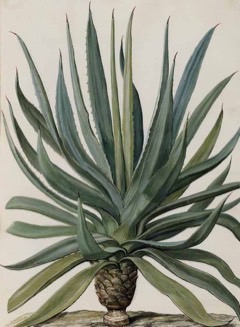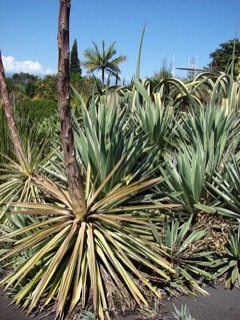 |
|
edibleplants.org |
 |
| Forest & Kim Starr wikimedia.org |
Translate this page:
Summary
Sometimes misspelt as Agave vivipera
Physical Characteristics

 Agave vivipara is an evergreen Perennial growing to 1 m (3ft 3in) by 1 m (3ft 3in) at a medium rate.
Agave vivipara is an evergreen Perennial growing to 1 m (3ft 3in) by 1 m (3ft 3in) at a medium rate.
See above for USDA hardiness. It is hardy to UK zone 10.
Suitable for: light (sandy), medium (loamy) and heavy (clay) soils, prefers well-drained soil and can grow in nutritionally poor soil. Suitable pH: mildly acid, neutral and basic (mildly alkaline) soils. It cannot grow in the shade. It prefers dry or moist soil and can tolerate drought.
UK Hardiness Map
US Hardiness Map
Synonyms
Agave vivipera (incorrect). Many.
Plant Habitats
Edible Uses
Edible Parts: Flowers Fruit Leaves Sap Stem
Edible Uses:
Many, if not all, of the reports on the uses of this species actually refer to A. Angustifolia. To date we have not found any reports that definitely refer to this species. Since A. Angustifolia is very similar, it is quite possible that both species have similar uses[K ]. Below are the uses listed for A. Angustifolia:- Flower buds and flowers[662 ]. Young flower peduncles[662 ]. Stems[662 ]. Leaf bases[662 ]. Fruit[662 ]. The flowering stems are cooked and their juice extracted, fermented, and distilled into alcoholic beverages[662 ]. The sap can be concentrated into a sweet syrup known as 'Agave Nectar' or 'Agave Syrup'[360 ].
References More on Edible Uses
Medicinal Uses
Plants For A Future can not take any responsibility for any adverse effects from the use of plants. Always seek advice from a professional before using a plant medicinally.
Dysentery
Many, if not all, of the reports on the uses of this species actually refer to A. Angustifolia. To date we have not found any reports that definitely refer to this species. Since A. Angustifolia is very similar, it is quite possible that both species have similar uses[K]. Below are the uses listed for A. Angustifolia:- The juice of the cooked leaves and stems, and a root infusion, are taken internally or used as poultices for both internal and external swelling, as well as for bruises, liver and kidney diseases, arthritis, and dysentery[662]. The roots are diaphoretic and diuretic[360].
References More on Medicinal Uses
The Bookshop: Edible Plant Books
Our Latest books on Perennial Plants For Food Forests and Permaculture Gardens in paperback or digital formats.

Edible Tropical Plants
Food Forest Plants for Hotter Conditions: 250+ Plants For Tropical Food Forests & Permaculture Gardens.
More

Edible Temperate Plants
Plants for Your Food Forest: 500 Plants for Temperate Food Forests & Permaculture Gardens.
More

More Books
PFAF have eight books available in paperback and digital formats. Browse the shop for more information.
Shop Now
Other Uses
Agroforestry Uses: Many, if not all, of the reports on the uses of this species actually refer to A. Angustifolia. To date we have not found any reports that definitely refer to this species. Since A. Angustifolia is very similar, it is quite possible that both species have similar uses[K ]. Below are the uses listed for A. Angustifolia:- Often planted in hedges[331 ]. Other Uses: A fibre from the leaves is used for making rope[662 ]. The leaves are used for thatching[662 ]. The spines on the leaves are used as nails or needles[662 ]. The flowering stem can be used as posts, rafters, and fences[662 ]. The root contains saponins and can be used as a soap substitute[331 ]. The sticky sap of the leaves is added to whitewash to make it adhere to walls[331 ]. The dried plant is burnt for fuel[662 ]. Carbon Farming - Industrial Crop: fiber. Agroforestry Services: living fence.
Special Uses
Carbon Farming
References More on Other Uses
Cultivation details
Agroforestry Services: Living fence Industrial Crop: Fiber Management: Standard Regional Crop
Agave vivipara is a stemless, succulent plant. Requires a sunny position[423]. Requires a well-drained soil[423]. Succeeds in poor soils[423]. Established plants are very drought resistant[423]. A monocarpic species - the plant lives for a number of years without flowering but dies once it does flower. However, it normally produces plenty of suckers during its life and these continue growing, taking about 10 - 15 years in a warm climate, considerably longer in colder ones, before flowering[11]. Climate: subtropical to tropical. Humidity: semi-arid to humid. Carbon Farming - Cultivation: regional crop. Management: standard.
Carbon Farming
-
Agroforestry Services: Living fence
Simply managed rows of shrubs and trees.
-
Industrial Crop: Fiber
Clothing, rugs, sheets, blankets etc. Currently, almost none of our fiber are produced from perennial crops but could be!
-
Management: Standard
Plants grow to their standard height. Harvest fruit, seeds, or other products. Non-Destructive management systems.
-
Regional Crop
These crops have been domesticated and cultivated regionally but have not been adopted elsewhere and are typically not traded globally, Examples in this broad category include perennial cottons and many nuts and staple fruits.
References Carbon Farming Information and Carbon Sequestration Information
Temperature Converter
Type a value in the Celsius field to convert the value to Fahrenheit:
Fahrenheit:
The PFAF Bookshop
Plants For A Future have a number of books available in paperback and digital form. Book titles include Edible Plants, Edible Perennials, Edible Trees,Edible Shrubs, Woodland Gardening, and Temperate Food Forest Plants. Our new book is Food Forest Plants For Hotter Conditions (Tropical and Sub-Tropical).
Shop Now
Plant Propagation
Seed - surface sow in a container in a light position. The seed usually germinates in 1 - 3 months at 20°c[133 ]. Prick out the seedlings into individual pots of well-drained soil when they are large enough to handle and grow them on in a sunny position until they are at least 20cm tall. Division of suckers. Bulbils.
Other Names
If available other names are mentioned here
Caribbean agave, century plant, maguey, narrow-leaved century plant
Native Range
SOUTHERN AMERICA: Aruba, Netherlands Antilles (Bonaire, Curacao)
Weed Potential
Right plant wrong place. We are currently updating this section.
Please note that a plant may be invasive in one area but may not in your area so it's worth checking.
An environmental weed and should be controlled in sensitive bushland and conservation areas.
Conservation Status
IUCN Red List of Threatened Plants Status : This taxon has not yet been assessed

Growth: S = slow M = medium F = fast. Soil: L = light (sandy) M = medium H = heavy (clay). pH: A = acid N = neutral B = basic (alkaline). Shade: F = full shade S = semi-shade N = no shade. Moisture: D = dry M = Moist We = wet Wa = water.
Now available:
Food Forest Plants for Mediterranean Conditions
350+ Perennial Plants For Mediterranean and Drier Food Forests and Permaculture Gardens.
[Paperback and eBook]
This is the third in Plants For A Future's series of plant guides for food forests tailored to
specific climate zones. Following volumes on temperate and tropical ecosystems, this book focuses
on species suited to Mediterranean conditions—regions with hot, dry summers and cool, wet winters,
often facing the added challenge of climate change.
Read More
Expert comment
Author
L
Botanical References
Links / References
For a list of references used on this page please go here
A special thanks to Ken Fern for some of the information used on this page.
Readers comment
| Add a comment |
|
If you have important information about this plant that may help other users please add a comment or link below. Only comments or links that are felt to be directly relevant to a plant will be included. If you think a comment/link or information contained on this page is inaccurate or misleading we would welcome your feedback at [email protected]. If you have questions about a plant please use the Forum on this website as we do not have the resources to answer questions ourselves.
* Please note: the comments by website users are not necessarily those held by PFAF and may give misleading or inaccurate information.
To leave a comment please Register or login here All comments need to be approved so will not appear immediately.
|
|